Polar Vantage Review
This Polar Vantage Review looks in detail at the Vantage M, Vantage V and Vantage V Titan models. All are packed with lots of true sports-related capabilities and market-leading innovations.

The Vantage models now have smart abilities yet their main focus will always be that of a multi-sport/running watch.
The Polar Vantage V is a replacement for the Polar V800 and thus competes with the Suunto 9 and Fenix 5/5 Plus/6/935 range. The Polar Vantage M is a lower-priced and fully-featured running/multi-sport watch which is an upgrade for Polar M400/M430 owners but also the direct competition to the Suunto Spartan Trainer, Garmin’s 735XT and COROS Pace, As of October 2020, this model has been superseded by the Polar Vantage V2 which I review here.
Polar realise that they will never match Garmin on the total number of smart, non-sport features offered. They target the needs/features of the ‘pro’ market (aka Elite+Age Group athletes) by leadership in selected areas of product competency. Specifically:
- Quality hardware, good aesthetics;
- An athlete-focussed platform (FLOW – app/web);
- Deep integration with Running Power;
- Advanced training load & recovery;
- The best wrist-based optical HR sensor (Precision Prime); and
- Accurate GPS/GNSS.
In Brief
-
Sports Features, Including App - 95%
95%
-
Price - 85%
85%
-
Apparent Accuracy - 80%
80%
-
Build Quality & Design - 95%
95%
-
Openness & Compatability - 90%
90%
In brief
 With the Nov 2019 updates, both Vantage V & M models now have most of the features for most people. The feature set on the watch and support on the Polar FLOW platform is impressive and tailored towards the more serious athlete. On the whole, the watch itself works well as a training and racing watch.
With the Nov 2019 updates, both Vantage V & M models now have most of the features for most people. The feature set on the watch and support on the Polar FLOW platform is impressive and tailored towards the more serious athlete. On the whole, the watch itself works well as a training and racing watch.
GPS and oHR accuracy do not stand out from the competition.
Vantage M is priced competitively for the impressive feature set, yet the Vantage V’s pricing for even more features struggles when compared to Garmin’s more expensive 935 or 945. The Vantage V Titan nicely compares to the sporty side of the Suunto 9.
Pros
- Very good and extensive sport features & platform that is continually improved.
- People generally like the aesthetics of this good-looking SPORTS watch
- Great sports format – lightweight, easy to use and generally readable screen.
- STRYD integration good – and now with ZoneLock and manual calibration
Cons
- oHR and GPS accuracy are improving from the levels noted at launch Edit: as of 21 Jun 2019, the HR is certainly better, although helped by warmer weather. And the GPS looks a bit better too.
- Retail prices are generally at sensible levels now and you can usually get one of these in the sales with the V sometimes being heavily discounted (try the Wiggle & PMC links)
Polar Vantage V Review, Polar Vantage M Review
I have been using the Vantage since September 2018 and, because of extended sporting trips, have over 300 hours of usage with them. This review draws on that experience but is also updated to include 2019’s new features. It will be updated throughout 2019 and into 2020.
I had a couple of meetings with Polar as well as and email exchanges and my opinions in this review flow from those meetings and from my time with the product(s).
For once this is a product that is targeted at ‘me’ the athlete, which I am stupidly excited about. Would it make ME switch from a Garmin 935 or Suunto 9?
This is a long review. There is EVEN MORE detail in the numerous links in many of the following chapters to other, related and detailed Polar Vantage posts. Now is your chance to skip forward to the section(s) that interest you. Otherwise, grab a latte and a biscuit, sit back, and enjoy the ride.
Polar Vantage Review – Unboxing – Contents
You get the watch and a bespoke USB charger. As well as numerous bits of paper you may also get the Polar H10 chest strap if you bought that in a bundle with the Polar Vantage V.

Also included is a free iOS/Android app; an online dashboard called Polar FLOW, and desktop syncing software called Polar FLOWSYNC.
Polar Vantage Review – So What’s New?
In a nutshell: these are two new Polar watches rather than incremental updates to the V800/M430
- Polar Precision Prime is a super-impressive looking optical heart rate offering that supports swimming. It contains innovations that include the ability to compensate for the HR signal quality, work across many sports types and improve the accuracy by post-processing the HR recording. It is made by Polar (not Valencell or anybody else)
- Polar now give Vantage V owners a running power figure which does not need any other sensor. This leverages the Vantage V’s internal barometer.
- Running power zones, and other running-with-power features, are supported via external pods by both Vantage models and by Polar’s own power calculations on the V.
- Full-screen data fields: There is a new full-screen data field for power, altitude, or HR.
- There is a new USB charging cradle.
- There are extended training load metrics and insights for both Vantage models and further RECOVERY insights for the Vantage V. The physiological algorithms are made by Polar (not Firstbeat)
- The new super low-powered GPS+GLONASS chip is made by Sony (probably CXD5603GF like the Suunto 9 and COROS APEX) and enables a superior battery life without needing a large battery.
- There is new COACH functionality which provides season planning for athletes and coaches. This further integrates with Polar’s existing abilities to create several complex workout types.
- Navigation functionality is missing as of 26Oct2018 but is on the official roadmap for Q1.2019 and route guidance is already listed officially as a product feature on Polar.com.
- Polar Vantage V TITAN – slightly lighter (59g vs 66g) than the V with a titanium case and textile-feel silicone strap
Take Out: There is some old stuff missing that was on the V800 but there is plenty of new stuff. There are a few gaps around navigation and a few peripheral gaps in other places like not being able to use power zones for complex structured workouts.
Polar Vantage V vs. M – What’s The Difference?
In a nutshell: the Vantage M differs from the Vantage V because it has: a shorter battery life; no onboard running power meter; and less of the peripheral stuff that might count as ‘minor feature’ to some (and a ‘key pro feature’ to others).
Let’s look at that in more detail:
- 40-hour battery life for the Polar Vantage V and 30 hours for the Polar Vantage M – each clearly has more than enough juice for an Ironman. Perhaps enough for most ultra runners? And yes that is full GPS and per second recording with oHR.
- The Vantage V has a barometer which is used as an input into the onboard running power meter
- The Vantage V has a touchscreen. However, buttons can perform virtually every action except scrolling through the high-level watch-face screens. The touchscreen is disabled when executing a workout.
- Running Power – STRYD/RunScribe compatibility is continued IN BOTH VANTAGE MODELS. BUT, to save you buying one of those 3rd party units the Vantage V has a built-in power meter…Further Details: here

- Only the Vantage V has Recovery Pro which looks at daily recovery as well as your balance between training stress and the recovery from it. (Polar H10 required for Orthostatic test inputs).
 M & V both have Training Load Pro which encompasses the load from your workouts based on HR (Cardio load using TRIMP); the sports-specific physical loads placed on your muscles during workouts (Muscle Load – measured by power in running and cycling); and your Perceived Load (like RPE).
M & V both have Training Load Pro which encompasses the load from your workouts based on HR (Cardio load using TRIMP); the sports-specific physical loads placed on your muscles during workouts (Muscle Load – measured by power in running and cycling); and your Perceived Load (like RPE).
- Training Load LEVELS are also produced and it looks like these are used in an adaptive way – still based on TRIMP but also on your recent workout performances.
- Some of the new metrics introduced are comparable with those from Firstbeat eg Cardio Load Status. However, other insights like Injury Risk are innovative and sometimes useful.
- The Vantage M has easily 22mm interchangeable straps.
Finally (May 2019) there is a premium version called the Vantage V TITAN which is made of lighter TITANIUM and has a different strap. Remember that early releases of the Vantage V had GPS issues so beware of secondhand devices.
Take Out: The Vantage V and Vantage M models are more than sufficiently differentiated in my opinion. The cheaper Vantage M has a LOT of sports functionality and, I suspect, it will be great for most runners and triathletes. I can happily use the M model with STRYD and the only very slight reason I prefer the V would be for its slightly better construction quality and button-feel. Recovery Pro would be useful for athletes who currently do not consider recovery or who use 3rd party recovery metrics.
Polar Vantage Review – Aesthetics, Interactions & Options
In a nutshell: the Vantage V has a slightly higher quality construction and a touchscreen. The Vantage M has interchangeable straps
This section looks at the exterior design of the watch and the exterior options you have when buying it eg colours.
Detailed Technical Specifications: link to: the5krunner.com
 Polar Vantage Aesthetics – Opinion
Polar Vantage Aesthetics – Opinion
I like the aesthetics. The 10, or so, people who I showed the Vantages to commented positively on the Vantages’ looks.
I’d say it has “gender-neutral, sporty prettiness”. Very PC.
Polar Vantage Body
 The Polar Vantage V has a premium construction of stainless steel and Gorilla Glass 3 whereas the Vantage M is a lighter ‘plastic’ construction but with a metal bezel.
The Polar Vantage V has a premium construction of stainless steel and Gorilla Glass 3 whereas the Vantage M is a lighter ‘plastic’ construction but with a metal bezel.
Both have a 46mm dia face and a usable screen size of about 31mm dia.
The Vantage M is very light at 45g and the Vantage V still light at 66g – yes the cheaper model is lighter.
The rear sees the impressive-looking Precision Prime optical heart rate sensor array. The 4 silver discs act as both a charging connection and a sensor to understand how well-fitted the Vantage is on your wrist. You know what all the LEDs do and that more LEDs and more colours might mean a better signal. More on that later.
Polar Vantage Straps
Each watch body is only available in one size, however, there are different strap length options S-M for wrist 130-185 mm; M-L: 155-210 mm
- Vantage M : Sizes S-M : Colour options black, red, or white straps
- Vantage M : Sizes M-L : Colour options black, white, or red straps.
- Vantage M : Recycled PET, interchangeable 22mm accessory bands: Colour options white melange, orange and petrol
- Vantage V : Sizes M-L : Colour options black, white, or orange straps.
- Vantage V : Size S : Additional $/Eu9.90
The Vantage M bands are easily interchanged for ‘fashion’ purposes (@$/Eu29.90). The Vantage V band can be changed in a ‘it broke’ scenario.
 Polar Vantage Display & Interaction
Polar Vantage Display & Interaction
Both models have 5 button operation but the Vantage V also has a touchscreen which is disabled during exercise. There is, almost always, a button alternative that exists to the touchscreen. The 240x240px screen is always on and there is a wrist-twist activated backlight. Sometimes the backlight is a little too dim for me and the font size for the feedback like from the Recovery Pro is quite small.
The 5 button-based interaction works very well. There is logic to how the interface works and that logic also minimises in-sport errors from miss-presses.
The high-level summary screens are: workout history; activity – steps & calories; training status; and heart rate, and can all be selected for more detailed info on each of those areas.
The bottom left button brings up important sport-related functionality where you: select a sports profile; perform an orthostatic test (waking HRV test, Vantage V only with H10/H7); or look at options for you and your watch. The more complex configuration of, for example, a sports profile is carried out in Polar FLOW.
Existing Polar users will become quickly familiar with how Polar has structured the watch’s interface.
Some Polar Vantage owners will want a selection of watch faces. Currently, that choice is limited to 2: digital and analogue. The likely expansion of what is offered here will be by adding different CONTENT to these watch faces rather than by allowing new watch faces or colour customisability of watch faces.
Take-Out
It all works well and I am happy. If I had to be critical I would say that the watch screen; sport profiles; and the details below each summary screen all have a quite different look and feel to each other. To the point where they appear to be designed by different people. It doesn’t bother me in the slightest. It’s just a little unusual, quirky maybe. I like quirky.

Polar Vantage Review – New Screens
These are some of the on-watch screens that you will see outside of a workout. So here we see some of the higher-level training status screens, the orthostatic test results and activity status screens. Also shown are some of the screens you see before and after a workout.
Take Out: It’s all nice enough and I don’t think particularly better or worse than found on other products.
Before looking at some of the pages you might see whilst exercising let’s take a quick step back to FLOW where you configure your workout screens for those all-important workouts.
It is an almost de-facto standard across many round watches that you can comfortably have up to 4 data fields per screen – Polar does this too. Polar also lets you have 10 (ten) screens per sport, which is more than enough. Perhaps more interestingly there is a new type of ‘GRAPH’ full-screen data field.

Workout Screens
Here are images of those screens from FLOW shown on the Vantage.
The full-screen GRAPH is available to show; power, elevation and HR. Whereas the Zone Pointer is only available for HR. You can also display the clock face during a workout and there is an intriguing ‘Interval Timer’ option (not shown, not yet working 26Oct2018 – to be added in feature release 2).
Take Out: It’s all pretty and readable with LOTS of data options to display on lots of screens.
Polar FLOW
In a nutshell: Polar FLOW is arguably, and with caveats, the best platform for athletes by any sports watch manufacturer.
The FLOW app and online FLOW dashboard are good. FLOW doesn’t look quite as slick, modern and fancy as Garmin Connect but FLOW is probably better-geared towards your device admin and post-exercise stats than Garmin Connect. FLOW simply has LESS gumph and clutter to contend with. Both are good but, as an ‘athlete’, I have a slight personal preference to FLOW. At the same time if you want to do DEEP analyses of your workouts then neither Garmin Connect nor Polar FLOW has what you need and you will take your data elsewhere.
This is NOT a review of Polar FLOW but Polar FLOW *IS* an important part of what you are buying in to. So I will highlight some key points for those of you thinking of switching to Polar, especially because there appear to be commonly-held views that Polar lack certain types of workout functionality.
Polar FLOW App
Let’s start with some selected images from FLOW for Android; iOS is highly similar.
Polar FLOW Online
There IS more functionality available online than on the app, including season planning, workout creation and workout scheduling.
Polar FLOW’s dashboard looks quite simple at first glance but, as you can see from the images below, there is a WEALTH of information and personal understanding to be had when you explore deeper.
Existing Polar users MAY not see these screens until a Vantage is linked to their account.
Take Out: I’ll keep it simple. FLOW is a comprehensive platform for athletes. I would definitely recommend the FLOW platform.
Sensor, Battery, Other Tech Details
I will cover some of the internal technical components and external sensors that the Vantages can link to. Precisely how some of these function may be crucial for how YOU workout.

3rd Party Sensors, Polar Sensors
Either Vantage model supports Bluetooth SMART sensors and the following are ALL equally supported by BOTH Vantage models: dual-sided bike power meter (eg ASSIOMA); dual-sided running power meter (ie RunScribe); heart rate monitors; cadence sensors; speed+distance+incline sensor; and footpods.
- The sensible money would be that Polar will now NEVER support ANT+. Let’s move on but stay hopeful. Most of you will have dual-band sensors in any case. I do.
- By default, GNSS (GPS+GLONASS) is the source of pace and distance. An active and paired footpod will take over the pace and distance you see on the Vantage but your GNSS track will still be recorded for viewing later.
- A footpod will NOT be the source of PACE/SPEED for the Vantage V power calculation.
- STRYD/Runscribe are always the source of power and also work on treadmills.
- A power meter calibration icon appears on the sports profile before you start the workout. It’s a neat place to easily enable PM calibration without having annoying/useful calibration prompts popping up.
- The H10 chest strap does cache workout HR data capabilities (only via BEAT app for now though). Currently, the Vantage has no way to retrieve such data.
- Multiple 3rd party sensors of the same type can be saved in a ‘sensor pool’. I didn’t see what happens if two of the same type are present and active.
- Dual-sided sensors like the ASSIOMA bike power meter can sometimes be paired as two separate sensors rather than via a single ‘master’. Pair to a single Unified BLE channel, if available.
- Any Bluetooth SMART chest strap should pair. IIRC from the V800, Polar treats RR data especially and only accepts it from a Polar HRM ie the H7 or H10. RR/HRV data is definitely used by the Vantage in the Orthostatic tests. I would be surprised if RR beats are not recorded during workouts and sync’d through FLOW – although when subsequently exporting from FLOW there is no guarantee that HRV data will be sent (not tested).
- Whilst the Vantage models have their firmware updated via FLOWSYNC or the FLOW app, Polar BLE sensors like the H10 need firmware updating via the Polar BEAT app. The BEAT app can also enable options for Polar sensors like, for example, enabling the H10 to simultaneously ACTIVELY PAIR to two receiving devices or enabling the H10 to cache workout data for the FLOW app.
Official Compatibility with 3rd Party Sensors is here: link to Polar.com
 Battery Issues
Battery Issues
Battery life is very good at 30 hours of GPS recording time with oHR and per second running for the Vantage M. It’s 40 hours for the Vantage V. That is enough for the vast majority of athletes.
The battery life will be extended by using a chest strap. It would be further extended if you turned off GNSS/GPS in FLOW for your sports profile. There is no reduced GPS/GNSS update frequency option. Remember that the GNSS chip IS normally a big power consumer but the new SONY GPS chip is frugal with its battery requirements. So I’m not sure if there are material gains in battery life to be achieved by turning it off. Maybe an extra hour or so might be a good guess.
Barometer, Altimeter
Both Vantage models have an altimeter and can give you altitude/elevation. However, the Vantage M derives that from 3D GPS+GLONASS positioning whereas the Vantage V also uses a barometer.
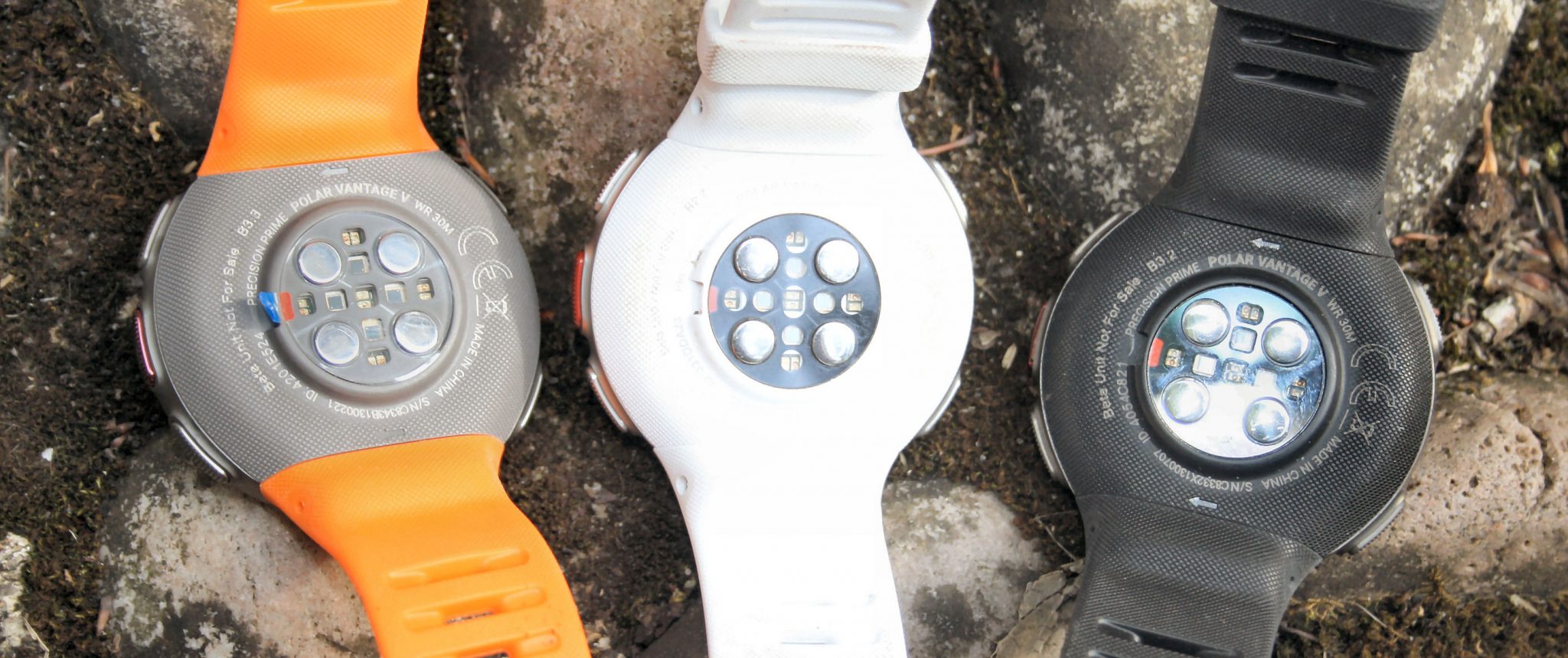
GPS / GNSS
The new Sony Chip is always GPS+GLONASS. GPS can be turned off either in the sport (via FLOW) or by choosing an indoor sports profile. This will improve battery life.
Predictive A-GPS is used by the Vantage to get an initial fix – this is NOT unusual. However, the Vantage does seem a little slow to me, often taking more than a minute to get a lock (under investigation Nov2018).
Technical Specifications – Polar Vantage Review
Full, comparative, Polar Vantage technical specs and further commentary are given in this link, handily compared to the V800 and M430 in case you were thinking of upgrading.
Polar Vantage Specifications M Vantage V, V800 M430 Comparison
Sports Usage
I’ll cover the main triathlon sub-sports plus weights, taking a look at some of the practicalities and niceties of using the Vantage in each sport. ‘Special Features’ of the Vantage are covered in subsequent sections
Run Usage – Polar Vantage Review
Either Vantage is highly suitable as a runner’s watch. Unless you are training 5/6 days/week or want an inbuilt power meter, then the Vantage M will be perfectly fine. Indeed the lighter weight and lower price of the Vantage M will be a clincher for many.
Vibrations and audible alert levels are sufficient for the purpose when running. Vibration feedback can additionally be disabled. The Vantage V also allows sound to be disabled or 1 of 3 volume settings chosen. The M does not have sounds although the vibration is faintly audible. Here are some other running features that will be key to some of you and unimportant to others:
- There is a ‘tap the watch’ feature that triggers a manual lap on the Vantage V’s touchscreen. That’s much easier than pressing a button. It sometimes needs more of a whack.
- Autopause can be disabled or set to a pace of your choice for it to kick in.
- Predefined or freeform Zones can be set for HR, speed/pace and power.
- Zone Lock is not available on the Vantage until Spring 2019 (you would normally press and hold the START button to activate HR/pace Zone Lock on the V800).
- Training reminder – for example on a marathon you could set a reminder to notify you to drink or eat at certain times/distances without triggering a LAP event. This is not (yet) supported on Vantage.
 Running on a treadmill with POWER from the Vantage V’s algorithm will be problematic as the algorithm currently requires GPS. ie the Vantage V currently won’t produce Power on a treadmill even if you have a normal footpod. However, STRYD or RunScribe will work with either Vantage on a treadmill to produce power, speed and distance. Polar should allow non-power footpods to be an input to their own power calculation, even if only to make it more accurate!
Running on a treadmill with POWER from the Vantage V’s algorithm will be problematic as the algorithm currently requires GPS. ie the Vantage V currently won’t produce Power on a treadmill even if you have a normal footpod. However, STRYD or RunScribe will work with either Vantage on a treadmill to produce power, speed and distance. Polar should allow non-power footpods to be an input to their own power calculation, even if only to make it more accurate!
Laps and auto-laps work well. Polar treats phases of training/manual laps and auto laps differently and can record two layers of ‘laps/phases’ – that is different/better to how Garmin works. Flow further allows custom lap distances to be viewed on FLOW.
All data metrics that I frequently use are available. Some appear missing like LAST LAP.
When running outdoors with GPS, the instant pace that is shown is somewhat variable to the point where it can’t be relied on (common across many brands), although once you have progressed through a lap/autolap then the lap/autolap pace becomes accurate.

Bike Usage- Polar Vantage Review
When cycling, a watch is best worn either on the handlebars or on the underside of your wrist. In either of those scenarios the oHR might not work (well or not at all) and the GPS antennae will be facing the wrong’ way. Indeed a watch is NOT great to look at when the text is relatively small and when you are going at some speed. Thus a larger, handlebar-mounted cycling device is always a better option for frequent cyclists.
However, for occasional or non-competitive use, a wristwatch is perfectly fine.
The same types of sports functionality are available as with running.
We will see later that oHR accuracy is reduced when cycling on bumpier roads but good for turbo trainer modes.
Whilst ‘Route Guidance’ is not initially available I would imagine that, when available and whilst cycling, it will be tricky to use because of the small screen and a lack of turn-by-turn instructions.
Most data metrics that I would use are available, the important ones are available.
Swim Usage – Polar Vantage Review
OWS swim usage appears perfectly fine with the Vantage (not yet tested). We will look at OWS GNSS accuracy later.
Pool Swimming functionality is also good. We will look at POOL oHR accuracy later.
The Polar Vantage Reviewed here, lacks some of the more peripheral swimming functionality when compared to Garmin’s pool swimming offering. The ability to handle drill lengths (I don’t use that) and the ability to handle presenting data in rest periods between sets (I do use that) are not provided on the Vantage. Stroke rate, SWOLF, stroke type and the like are shown on FLOW – if you can’t see that data try the POOL SWIM sports profile next time 😉
Polar’s lack of rest period stats really will make about zero difference to me using the Vantage a lot more in 2019. So it has all I need for swimming. One extra bonus over the Suunto is that the Vantage is less chunky and less likely to catch a wetsuit.

Gym / Weights Usage
The flexibility of the WEIGHT/GYM sports profiles is somewhat limited. There are better apps and watches if the gym is your thing that you take seriously…I don’t. Such apps can count reps and guess at the exercise you are performing.
I used the STRENGTH TRAINING profile a few times and nothing was recorded apart from HR and hence cardio load was also recorded which, by definition, would be low. No muscle load figures were recorded in FLOW..

Triathlon / Duathlon / Brick Usage
Lots of non-serious, non-data-driven triathletes will find either Vantage watch perfectly fine for triathlon.
For a select few, however, some important but niche functionality is missing here.
IMHO, Polar need to add additional sports profiles that support extended training bricks and less usual multisport events like Otillo, Pool Triathlon, swim/aqua-bike and aquathlon. Pool triathlons are popular, all triathletes do brick sessions and awesome multisport athletes do Otillo. Even AquaBike is now an ITU Age Group event.
Having said that, the Vantage has a generic ‘MultiSport’ profile and that EASILY allows consecutive sports to be manually chosen. That’s OK for training but not when racing.
NB: A data-driven, age-group triathlete would be more likely to ALSO use a cycling-specific computer for the bike leg. The triathlon watch then becomes relegated to merely a workout logger whilst cycling (that’s perfectly OK, I do that). Polar H10 specifically enables this usage. I will have to test if a Vantage paired to an H10 records oHR in the OWS swim leg of a race.
 Other Usage
Other Usage
Using ZWIFT at the same time as logging the same session on any Bluetooth watch will be problematic as POWER METER sensors will not transmit BLE for the Vantage and BLE for ZWIFT. If your sensors also transmit ANT+ then you can capture that for Zwift via a BLE dongle, whilst the Vantage takes the single BLE signal for itself. Polar’s H10 will, most likely, support HR for both Vantage & Zwift – not tested.
Special Features
The Polar Vantage Reviewed here has several ‘special’ features. To me a lot of these are WOWs. But I fully appreciate some of you will be more in the ‘meh’ camp. Each to their own.
Special Features – Running With Power
Polar’s implementation of Running Power is awesome in many respects (except that parts of it shown on FLOW are not working at launch on the Vantage!). For me, RUNNING POWER is one of the reasons I’m planning to use the Vantage seriously in 2019.
In a nutshell: Both Vantage models support external running power meters. The Vantage V also calculates power on the wrist if you prefer that option. Running power is handled natively with separate running zones and running power alerts (via Zone Lock in 2019).
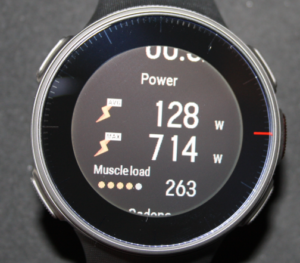 Polar has done the unthinkable here. They’ve released two Vantage models and yet BOTH support power. It’s unusual that the ‘lower’ model would also get power support. So this deserves a special thumbs up for Polar.
Polar has done the unthinkable here. They’ve released two Vantage models and yet BOTH support power. It’s unusual that the ‘lower’ model would also get power support. So this deserves a special thumbs up for Polar.
This might backfire on Polar (albeit in a nice way) in that I would plan to continue my use of STRYD but with the cheaper, LIGHTER Polar Vantage M. The Vantage M does everything I need it to and would easily last for an Ironman distance race. Thus, cleverly, Polar offers a lower cost watch-upgrade to existing users of RunScribe Plus and STRYD who want potentially better, native power integration.
At the same time if you don’t already have a running power meter then you could go for the top-end Vantage V model. That uses an algorithm and inputs from its inbuilt barometer to come up with Polar’s version of power.
Native support for running power is not currently offered by Garmin eg Garmin does not have power zones for running.
Running power ‘just works’ on the Vantage V, there is no need to add apps or extra data fields in order to link to sensors. Running power data fields are already built into FLOW/VANTAGE and are easily chosen.
Polar has separated out running power zones from cycling power zones, which was previously an issue ie the 2 sets of zones are separate and working both on FLOW and the watch.
Polar’s power zones for running are either custom-defined or based on MAP, which is comparable to FTP and FTP is used for cycling power zones.
Power alerts will come when Polar implement the Zone Lock settings (2019) – the Zone Lock option initially appeared in FLOW but is not currently enabled on VANTAGE.
Take Out: Once Zone lock is enabled VANTAGE/FLOW will be an excellent platform for running with power. Probably the best one. In the longer term Flow would further benefit from CP-related analyses and running power training programs – in reality, those two areas will be low on the current priority list of new functionality.
Special Features – Precision Prime & HR
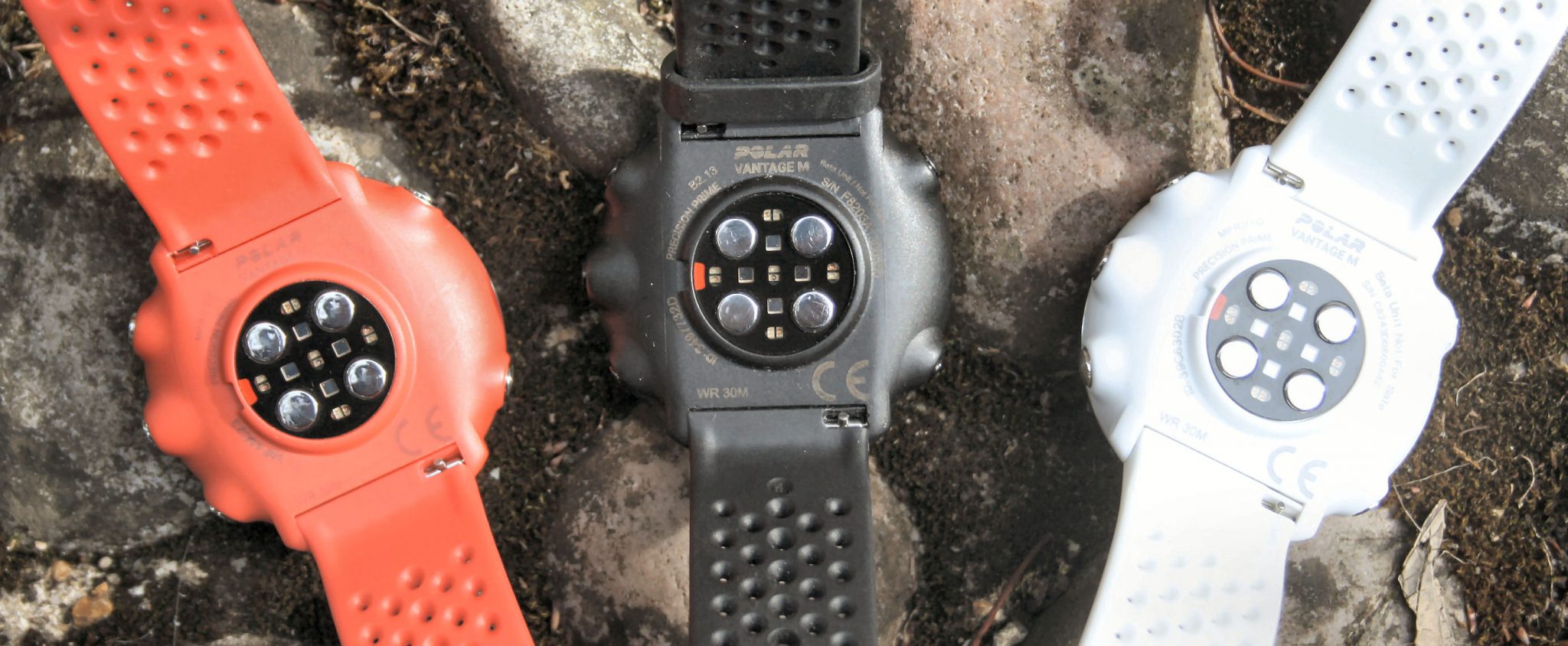
If looks were anything to go by then the Precision Prime array on the rear of the Vantage would clearly be the best in the world.
The headline design elements are 5 GREEN light LEDs and 4 RED light LEDs making a total of 9 LEDs and it looks like there are 4 or 5 sensors that receive the light back. Well-spaced, multi-coloured LEDs should give the potential for an accurate sensor (see accuracy section later). This is the same sensor on each of the Vantage models.
However, Polar has taken oHR tech several steps further:
- The 4 metal sensors on the rear are how the device is charged but they also double up as sensors to determine skin contact. I have numerous non-Polar devices that fire away endlessly with the optical HR unit when I’m not wearing it. Polar turn it off within a few seconds of the device being removed from your wrist. This both saves battery and also minimises the risk of the Vantage trying to find an HR signal in the ether (they often do)
- The quality of contact and other factors are used by Polar to determine the quality of the oHR reading they have made and displayed to you. Post-processing of the HR by the Vantage will then also improve the HR track for when you get back home to load it up to your favourite analysis platform.
- The Vantage delivers 24×7 HR through Precision Prime, this can be disabled.
Polar has now joined Suunto (NOT Garmin) by enabling optical HR whilst swimming. The results are not perfect and the device needs to be worn especially tightly. However, Polar is confident that oHR from swimming can still make meaningful input into a triathlete’s overall training load (I agree).
For the Orthostatic test to work on the Vantage V (not M) you will need a Polar H7 or Polar H10 chest strap. Nothing else will work. Without that, Polar’s Recovery Pro will not work fully.
The V800 could show live HR whilst swimming via the 5KHz signal from a chest strap but note that the 5KHz signal can never work with the Vantage. Instead, you use oHR or cache a separate HR track via the Polar OH1.
Some of these themes touched on in this Polar Vantage Review are expanded upon in more detail via this linked post.
Polar Vantage M & V – Precision Prime oHR – A Detailed Look and other new HR tidbits
Take Out: The concept of Precision Prime is smart and, dare I say, almost breath-taking in some aspects of its novelty. I was super impressed by the theory. All it has to do now is deliver the results.
Special Features – Training Load & Recovery Pro
I have been using near-identical concepts to parts of Training Load/Recovery Pro for several years and the following is based on my historical knowledge of similar concepts; my time with the Vantage; AND information from Polar. Here goes…
Amongst other things, Training Load and Recovery Pro boil down to answering “How hard can I train today?“
On the one hand, Training Load provides a holistic view of the training stresses to your body and, on the other hand, Recovery Pro is creating a view on how well you have recovered from those stresses. These two are then brought together and you are given actionable, personalised feedback.
By looking at trends of the underlying data you can ensure that you are continually and progressively stressing your body AND also identifying risk factors in your training where the state of your body might make it more susceptible to injury/illness.
Polar will give you feedback to all of this in ‘Plain English’ on your watch/app as well as giving the inquisitive amongst you the ability to delve deeper into the details on Polar Flow.
If you want to delve deeper then you might want to understand all the info in the following section. If not, skip the rest of this section NOW and do what the watch tells you to 😉
Let’s start with some terms…
Polar’s Total Training Load is 3 algorithms which are based on cardio load, muscle load and perceived load
The inputs come from: heart rate data from workouts; power data from power meters; and subjective feedback on the watch by you after workouts.
The Recovery Pro algorithm gives feedback on your load and on your recovered state. It is based on waking HRV (Orthostatic) tests and subjective feedback on your sleep quality, muscle soreness and overall fatigue.
The heart rate data from workouts and heart rate (HRV) data from Orthostatic tests are the fundamental prerequisites for Training Load and Recovery Pro respectively. All the other components refine Polar’s algorithms rather than being essential for them to work.
Training Load – V & M
Your Total Training Load is based on Muscle Load, Cardio Load and Perceived Load. Each of these 3 components is rated on a scale of 1 to 5.

Let’s look in more detail at the constituent parts of training load.
Muscle Load
Muscle load is measured in the sense that it is derived from ‘power’ data that you might have available from running and cycling.
It will be shown in various places AFTER your workouts such as in a workout summary on the watch or on the workout summary in Flow.
Muscle load might ALSO appear in FLOW when it can be based on biomechanical formulae, possibly after weights sessions. Although I have not seen that behaviour after the weights sessions I performed.
My understanding is that it is not the absolute power level that is important but rather relative levels over time – thus it doesn’t matter which POWER source you have ….as long as you always have the same source.
Perceived Load
Perceived Load is optionally estimated by you and entered manually on FLOW. I assume the subsequent calculations are based on RPE-TRIMP.
From my knowledge of ‘normal’ TRIMP: normal TRIMP falls over somewhat when looking at team sports and weights. I believe RPE TRIMP is used by Polar to fill the gap left by normal TRIMP as clearly such sports DO place a load on the body even though your HR may be low. Firstbeat does something similar for team sports.
Polar cite McGuigan (2004), Lagally (2002), Soligard (2016)
Cardio Load
Cardio Load is the most important LOAD of the three and is based on your completed WORKOUTS and excludes general activity (steps). Luckily for endurance athletes, it is easily measured, well-understood and there are widely used implementations of this based on TRIMP. I’ve used TRIMP for many years.
You will see Cardio Load as the red dots on workout summaries and on your Vantage (shown above) and on the high-level calendar view in FLOW.
It’s worth looking into CARDIO LOAD & TRIMP a little more as it is used by Polar for a few different things.
Cardio Load is the measured form of TRIMP based on a weighted average of time in heart rate zones – eg 3 minutes in zone 5 is worth a lot more TRIMP points than from 3 minutes in zone 2. Polar told me that their algorithm also looks at Cardio Load in relative terms to your workouts in the last 90 days.
This chart on FLOW has a vertical RED BAR representing TRIMP points based on my heart rates for each workout. Polar use HR assessed via HRmax, HRrest and age – so they are important to be correct. Cardio Load is NOT based on your freeform HR zones (which I think is wrong, but there we go).

Then my strain/fatigue is the purple line (7-day m.avg TRIMP) and my tolerance/fitness as the blue line (28-day m.avg TRIMP). Generally, you want the blue line to trend upwards. When the blue line is higher than the purple line there’s a good chance of better performances; indeed in the period (26Sep-4Oct), above, I did 3 power-duration PBs. This is (effectively) the same as CTL/ATL/TSB which is widely used elsewhere.
Similar Cardio Load information is available on the FLOW app.
Full Training Load
However, as we’ve already said, Cardio Load is not the full picture of your Training Load
Below we see the results of the full load calculation. This cardio load status curve is similar to the cardio load buildup from above.
Cardio Load Status
This is a simple calculation of strain/tolerance (or fatigue/fitness). Polar present this information on your watch colour coded based on the following scale.
I was recently VERY NAUGHTY and almost managed to break the Cardio Load Status dial…almost. But not quite. And yes you do win a prize if you share an image below showing over 1.7 AND you not being injured 😉
You scroll down on the watch to a plain English description of what your current status means and what to do about it.
Cardio Load Status – Injury Risk
A component of the Cardio Load Status is your injury risk status. It’s the same calculation as for Cardio Load Status, it’s just that when the Cardio Load Status result exceeds 1.5 you are in the ‘Injury Risk Danger Zone’ (Gabbett, 2016).
This just means that you are given a further, modified warning on your increased likelihood of injury. From my personal experience with the TRIMP-based metrics, I’d say that it would be wise to be mindful of such a warning.
Recovery Pro – V Only
Recovery Pro is only available on the Vantage V.
The key pieces of actionable info you get are your daily insight to your recovery status which includes a short-term and long-term component in plain English. See the image to the right with short-term recovery at the top and long-term recovery underneath. Further below is an indication of the accuracy of the data underlying the feedback.
There are three inputs to Recovery Pro. Firstly there is the quantitative data from the Orthostatic test, secondly, there are the qualitative responses that your give to MOOD questions each morning and thirdly the long-term cardio load status. These are all factored in when calculating total recovery.
The key input into total recovery is a quick 2-minute test, 3 (or more) mornings a week. You MUST use only a Polar H10 heart rate strap (or Polar H7, nothing else). The Orthostatic test requires you to lie down for 90 seconds and then stand up for 90 seconds. Easy. You can even set a reminder schedule on the Vantage. Super Easy.
The other inputs to total recovery are your responses to questions like “How well did you sleep last night?” and “Do your muscles feel more strained than normal?”
Recovery and training load history are combined on the device where feedback is given but there are also some more interesting insights available on FLOW, such as these:
Orthostatic Test
I found in my research for this Polar Vantage Review that the Orthostatic Test uses HRV/RMSSD/RR data and IMO does a good job of flagging up ‘stress’. This can be stress from overloading because of too much training or ‘life stress’. The two cannot be distinguished but, either way, you need to address the cause of adverse readings as either affects your recovery from your workouts.
The test results are shown on your watch, as below, and schematically on the image to the right.
On FLOW you will get those results trending over time, like this:

I have a nagging doubt that the RMSSD data could have been better presented in FLOW. But it DOES do the job.
Recovery Pro Icons
Polar have realised the complexity of some of this information and have improved some of the feedback with, for example, traffic lighting on your watch in the daily feedback screen.
After 3 or 4 tests and mood inputs you should start to get more accurate feedback but over 8 tests in 28 days are required for full accuracy. One of these coloured icons (to right) will appear on your watch’s main screen with a plain English explanation.
If you really need more data points then an asterisk will appear on the icon, as shown below
Take Out: There looks to be some really awesome stuff here but don’t get too bogged down by the details. The awesomeness of it is somewhat let down by the interface to the results. But you get the hang of it all soon enough.
Special Features – Training Plans, Scheduling & Workout Creation
There are many gems hidden away on Polar’s extensive FLOW platform, these include the season planner (new); complex WORKOUT creation; and adaptive TRAINING PLANS (running).
Training Plans – Running
Polar’s existing adaptive training programs for 5k to 42k are sync’d through to the Vantage. I didn’t test these to completion with the Vantage but they seem to work. The ‘race time’ target for the end of the plan seems plausible.

Clear omissions are POWER based running plans and cycling plans
Training Plans – Scheduling with the Season Planner
For those of us who follow our own plans or who want a coach to do it for us, the season planner will be a neat and useful tool.
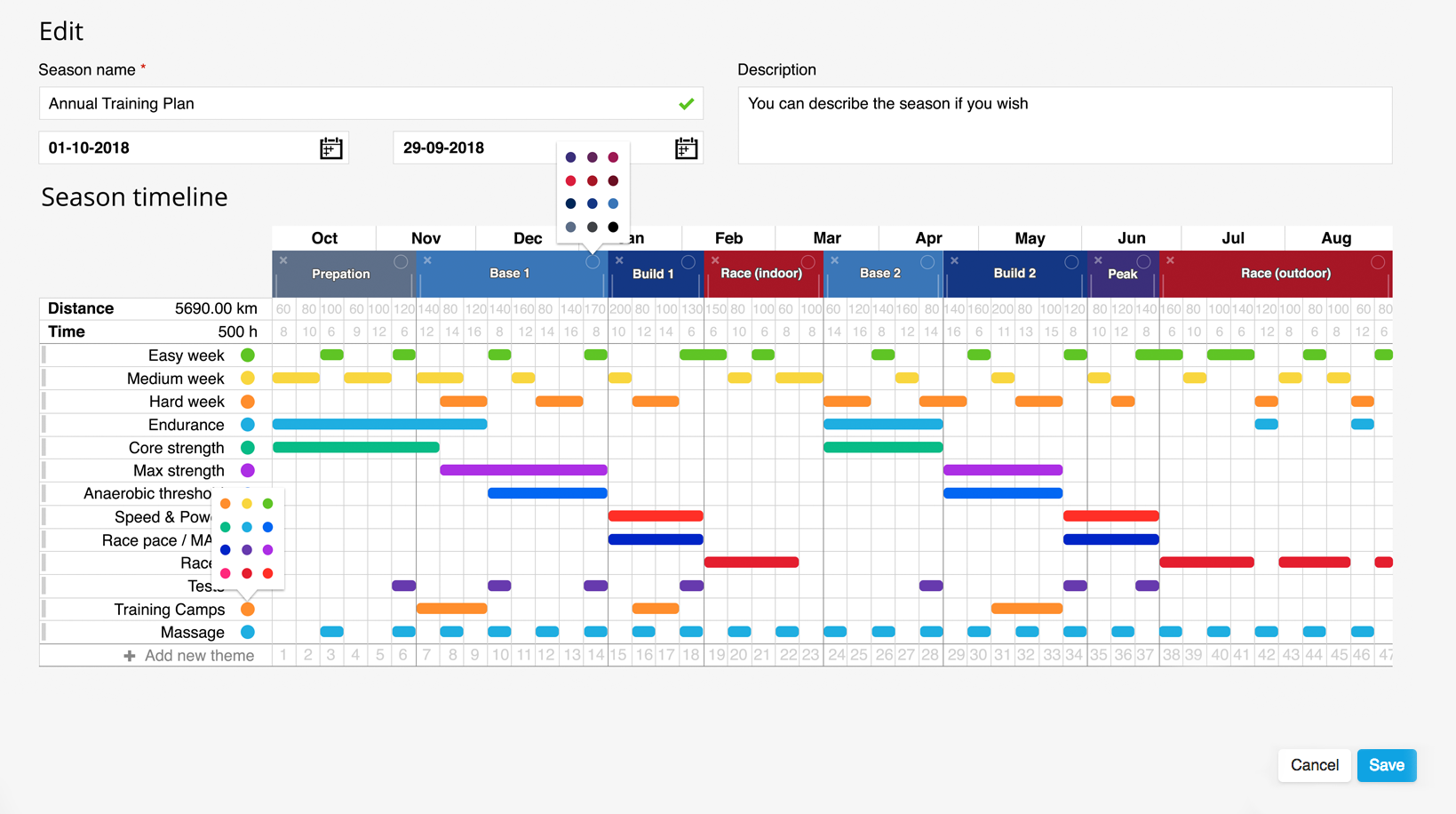
I’ve only had a quick play with the season planner for an hour and it is a powerful tool and easy to use.
At the overview level, it is a spreadsheet-like tool to balance and structure the various aspects/themes of your training over the year. In the above example, this would be where you plan your easy weeks, hard weeks, base training and so on.
Training Plans – Scheduling Favourite Workouts
You or your coach will then go on to build the structure of each week and assign specific workouts to specific day/times. If you or your coach already have a library of such workouts (as favourites) then it’s a simple case of drag, drop and sync those pre-existing workouts to your Vantage.

Training Plans – Creating Workouts

Polar call the types of individual workout they support Race Pace; Phased; Interval; Calorie; Distance; and Duration.
Some of these are DEFINITELY what others call ‘complex structured workouts’.
Creating Workouts – Special Case: Complex Structured intervals
These are intervals workouts where specific phases (groups of intervals) can also be repeated. Alerts are given on the watch at the end of phase periods/intervals and also when you are not in the correct zone but remember than the Vantage M has no audible alerts, so you only get the vibrate alert from the M – it works well enough.
These workouts will suit many athletes but the workouts do not support POWER.
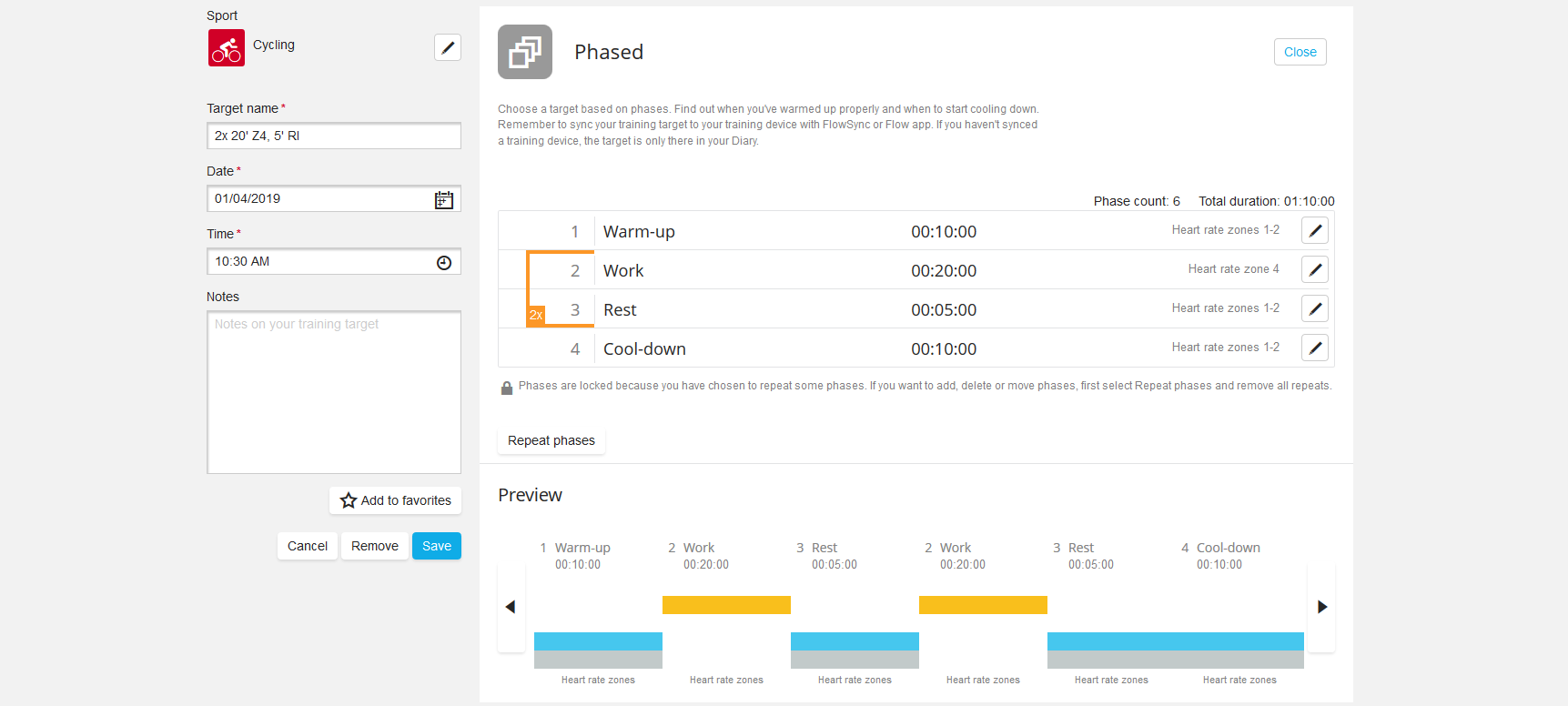
I have not tested this functionality through to following workouts through to completion on the Vantage. ‘Test’ workouts DO sync to the Vantage and can be started. They appear to then follow the time periods used in the creation of the custom workout.
Creating Workouts – Special Case: Race Pace
One of the more useful ‘pro’ workout features is ‘Race Pace’. I’ve not tested this in anger but this workout was sync’d to the Vantage and could be started.

Take Out: there is some great stuff here for coaches and the more organised amongst us who are self-coached athletes. With only a few minor exceptions this looks like a very powerful set of tools for the planning and execution of (complex) workouts.
Special Features – Notifications & Routing
Routing functionality and notifications were added in Feb 2019 and are discussed in more detail in the link below.
oHR Accuracy & GPS Accuracy
Polar has made a big play about wanting to be the best sports device for oHR and GPS accuracy. I have undertaken a lot of testing with both Vantage devices and the detailed look at many respects of accuracy is linked to below. I’ll first just summarise the differences
- Elevation Accuracy – Good
- OHR Accuracy – As good as Garmin/Suunto’s current tech and hopefully with further improvements to come from PRECISION PRIME. Swimming HR is included and is OK. The usual suspects affect oHR accuracy especially bumpy roads and free weights. I found wearing it tight and keeping my forearms warm improved accuracy. Edit: as of 21 Jun 2019 I thought that Garmin’s latest ELEVATE HR sensor was market-leading BUT NOW PRIME seems *BETTER* – caution, warmer weather improves results for this kind of tech
- GPS Accuracy – Not good on the Vantage V. Needs work. (Edit: As of 21 Jun 2019 – GPS is better)
- GPS Accuracy – Acceptably good on the Vantage M and on par with Garmin 935. Hoping for even more!
Data Export & Connectivity
Your watch syncs to iOS and Android easily enough and the charging cradle/disk also enables the PC-based FLOWSYNC to sync via a computer.
Different flavours of Android will likely have their own connectivity nuances.
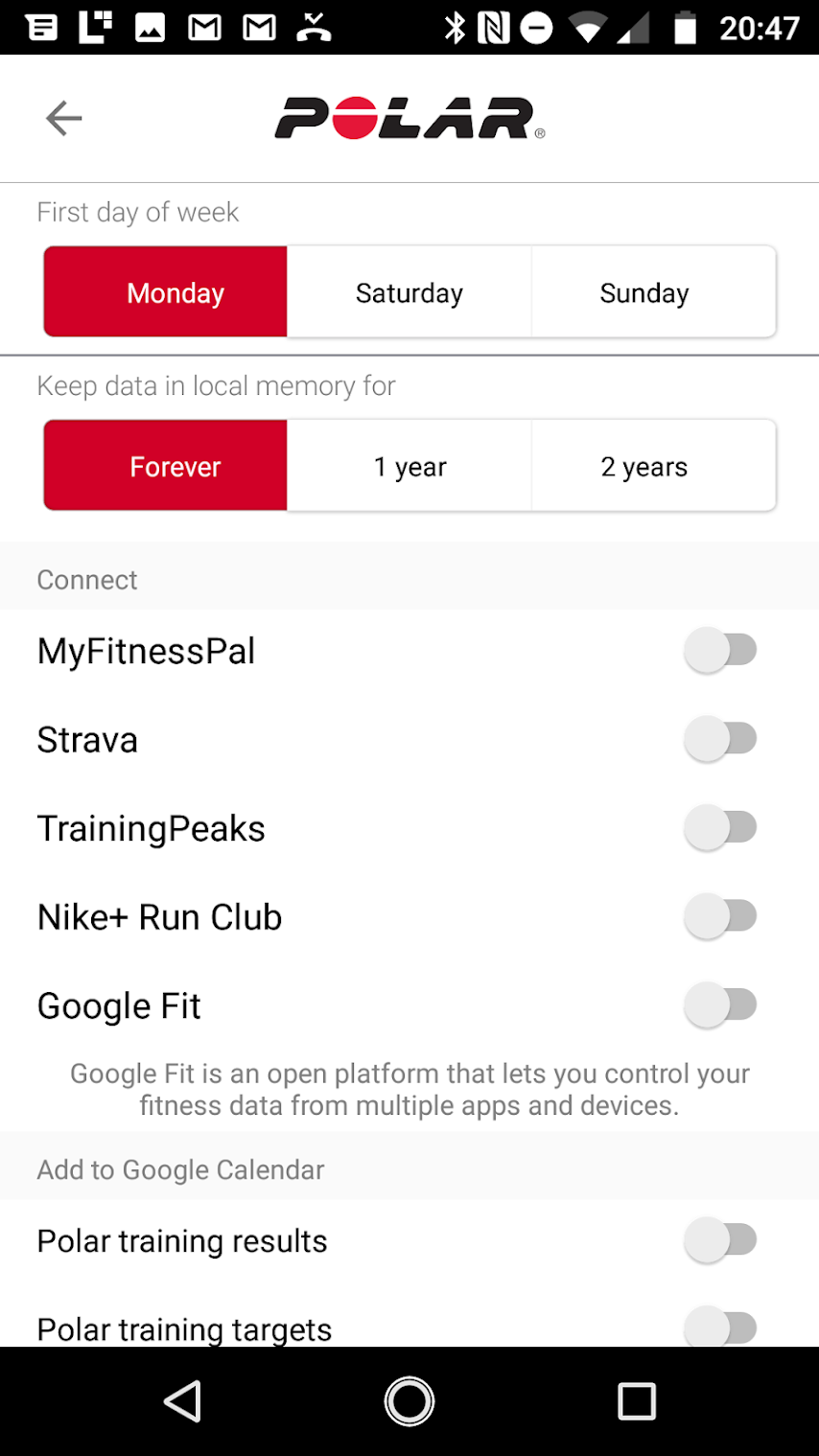
Polar now has more than adequate ways of getting your data out of FLOW and on to somewhere else, most COMMONLY to STRAVA. FLOW would benefit from a DROPBOX link for those of us who work with other software such as Golden Cheetah or SportsTracks (desktop).
FLOW currently does support inbound links of STRAVA routes and segments. However, none of this functionality is available to the Vantage in November 2018. Polar will introduce this in early 2019 as per their roadmap.
Unlike with Garmin’s FIT files, Polar export running power or bike power as the same thing: ‘power’. This potentially can cause issues elsewhere but the other major platforms that interface with Polar now seem to understand what they need to do to avoid the two lots of power data becoming mixed together in their systems.
Polar store autolaps and manual laps separately. It looks to me like autolaps are exported from FLOW unless there are manual laps/phases present.
Also: See next section
Tips, Tricks, Tidbits of Info
I’ll add interesting tidbits here as they come to my attention
- The letters “V” and “M” don’t mean anything as such (I asked). It’s just a continuation of the two ‘V'(800) and ‘M'(400/430) series
- Bulk export from Flow: https://flow-exporter.ddns.net
- Export from Flow (Android) http://syncmytracks.com
- Synchronised export from Flow: fitnesssyncer.com (read-only access to Flow’s Body composition and ACTIVITY)
- Official Polar Vantage roadmap: link to polar.com
- Vantage-related Polar communications: https://www.polar.com/blog/tag/polar-vantage
- Polar support updates: https://support.polar.com/en/updates
- Vantage V vs Vantage M vs V800: link to polar.com and vs M430 and V800 link to: the5krunner.com
- 5KHz/gymlink is NOT supported
- Tap (Vantage V) action supports take a lap but NOT change view and backlight.
- H10 really can send your BLE heart rate simultaneously to a bike head unit and the Vantage.
- Users of the Polar BALANCE Scale will need to sync weight values via the smartphone app NOT via the Vantage.
- Polar Balance will need to be used via FLOW ie not directly to the Vantage
- Treadmill Usage – Pace and Cadence IS shown when running indoors on a treadmill and is calculated from the accelerometer. A footpod will improve accuracy. However running power is not calculated on the Vantage V – on a treadmill neither from a footpod nor from the wrist
- Footpod Usage on a Treadmill – A Polar Stride footpod (not STRYD) shows pace and cadence from the pod. However, running power is not calculated on the Vantage V
- Running Index is calculated when using STRYD and GPS – needs 12 minutes of running. This definitely works in the generic RUNNING profile but other running profiles may be different.
- Vantage M & V both have vibration. Only the V has audio alerts. However, the vibration is audible to an extent.
- Vantage M Manual – link to polar.com
- Vantage V Manual – link to polar.com
- Problems?: Reset your device suing the desktop FLOWSYNC. You should not lose your settings. I had a period when I got crazy low oHR after a FW update. A reset sorted it out.

Polar Vantage – Bugs
I can’t keep an up-to-date list of every bug on every product I review or use. I’m only me.
This link shows some bugs. I don’t know how frequently it is updated or, indeed, if it is up-to-date as of today (whenever today is)
https://docs.google.com/spreadsheets/d/1emViclzhJEKGpA_uVEL2aWz0-Vdc5qll9M7_V4iaPeI/edit?usp=sharing
Polar Vantage – Futures
Looking at Polar’s V800 we saw many improvements over the years. Generally speaking, Polar invested in the product, although perhaps not as quickly as some would have liked.
Polar has produced a roadmap for the Vantage and, based on things that were hinted at in meetings with Polar, I hope and expect that the Vantage will see even more additions over the coming months and years.
Sensible advice is to buy the Vantage based on what is available now. But I would hope we will get these included at some point
- More swimming stats
- Power-based training plans and workouts
- Running dynamics from the H10
- Navigation (see roadmap)
- Retrieval of cached HR data from the Polar H10 chest strap
- STRAVA integrations (see roadmap)
- Perhaps even a cut-down model as a more direct replacement to the Polar M430
We’ve seen from Suunto and Garmin in recent years that they operate more of a ‘replacement’ business model rather than investing in developing the sports watch. It’s unlikely your Vantage will be quickly superseded, in my opinion. I expect it to be maintained and continuously improved over several years.
Is the Vantage the Best Triathlon Watch
Define: ‘best’?
Both Vantage watches are certainly candidates for the ‘Best Multisport Watch’ in some category based on their feature set. I’ve linked to a detailed post about that below.
Both ARE properly able to execute support for a triathlon race and, with only minor reservations, support you entirely through your training. If you want a smartwatch with other fancy features (not sport-related) then there are many options elsewhere…good luck!
the Best Triathlon Watch 2022 – Garmin, Wahoo, Polar, Apple & more
Polar does lack some peripheral triathlon features that SOME of you might consider being important. These are
- No sport-profile support for Otillo, pool-based triathlons and other unusual triathlon races (Polar’s Multisport mode DOES allow you to quickly switch between custom sports)
- No extended brick profile run-bike-run-bike-run…etc (Multisport mode allows you to quickly switch between custom sports)
- No support for H10 HR data cached when swimming. No support for older 5KHz underwater HR signals. (Polar would get you to use oHR for swimming)
- Some swimming features like swim workouts and the ability to better manage rest intervals
- No ANT+ support. Most new PMs are dual-band. I can only see the Zwift scenario where this could be a real issue (H10 does simultaneously support a head unit AND the Vantage). Yes by using BLE to link to a PM will lose special ANT+ power metrics.
- Zone lock for HR, power and PACE/SPEED
I’ll add some more in if I can think of them but that covers the main ones.
 Is the Vantage the Best Running Watch
Is the Vantage the Best Running Watch
Just as with the criteria for the best multisport watch you can find a smarter, tech watch elsewhere. Could you find a better running watch…I mean just for running, none of the other smart stuff?
The Vantages tick LOTS of boxes for the keen runner, these are:
- Other vendors have more physiological metrics but, to me, Polar’s Training Load seems ‘about right’ and probably better than my current solution. Polar’s Recovery Pro also seems ‘about right’ and is provided within the same, single overall system as their TRAINING LOAD – unlike the mechanisms I currently use.
- Footpod support,
- Running power support
- Polar does lack support for unusual sensor types but I suspect none of you will have a muscle oxygen sensor. Other than a temperature sensor that’s the only material sensor missing.
- Polar has the right focus, aiming for quality sensors and quality data.
- Polar has the right metrics for training and performance, as well as one of the better training platforms (FLOW)
- The watch has the correct ergonomics of a running watch – IMO.
- Polar offers adaptive training plans from 5k to 42k. These are at least as good as competitor offerings from what I’ve seen in the past. I’ve not fully tested the training plans on the Vantage.
Polar’s notable omissions are:
- NOW LIVE: Route Guidance: Breadcrumb navigation and related navigational functions
- NOW LIVE: Favourites on the Vantage or the ability to create intervals on-the-fly
- CLAIMED TO BE LIVE: Not enabling footpod to over-ride GPS a source of pace/distance whilst still recording a GPS track
- CLAIMED TO BE LIVE: Not enabling a footpod as a source of pace for Polar’s power algorithm
- NOW LIVE: STRAVA live segments
There is no other ‘great’ omission just several smaller ones. IE some things like direct Polar Balance Scale compatibility is on the V800 but not on the Vantage. You can bet that the omission of ‘X’ will, for sure, annoy someone who will then write a comment below saying that s/he won’t buy the Vantage because of that. Fair enough.
But of course, these omissions MUST be balanced with a great-looking watch that does have several important new bits of kit (Precision PRIME, integral running power) and new bits of software – Recovery Pro.
My future ‘bet’ would be that Polar will include almost everything that the V800 can do in the Vantage V.
“Exactly When?” would now seem to be in 2019. As of Feb 2019, Polar has already delivered on almost all of its promised Roadmap but I don’t have any insights that I will share beyond that. Note that Vantage is strategically important for Polar. So if Feature X doesn’t appear for a while there WILL be a good reason for that.
All the media who had a pre-release Vantage have had access to new stuff on Polar FLOW (online) which current Polar users can’t see. Some of what I have seen on FLOW is not available on the Vantage watches in the first retail firmware. However, we must all take some comfort in that there are new features now on FLOW waiting to be enabled on the Vantage.
So. To answer the question “Is Polar the best running watch” then my answer would have caveats and say that “Yes, it might turn out to be“. ie the V800’s accuracy and features combined with the new features and new looks would be a pretty awesome package.
As the kids say, “Are we there yet?”
 Polar Vantage Review – Summary & Opinions
Polar Vantage Review – Summary & Opinions
Polar was kind enough to design this watch for the likes of me…so I’m going to use it 😉
I like the Polar Vantage so much that I’m definitely going to race with it in triathlons in 2019. I’ve only ever previously used Garmin watches in triathlon/duathlon races.
Regardless of whatever happens with improvements to Precision Prime and GPS accuracy I’m always going to use STRYD and a chest strap. It’s just the way it is FOR ME. The current GPS accuracy for my post-race ‘pretty route picture’ on STRAVA is fine now.
What I would personally like from Polar is power zone lock for running, cycling and hence triathlon and cached swim HR data from the H10. What I personally NEED from Polar is a footpod to be a source for pace with GPS still recording – I probably won’t use the Vantage without that.
I like the FLOW platform and can recommend it. Yet, my ongoing use will be on SportTracks 3.1 and Golden Cheetah as that is where ALL my historical data is.
My personal plan for 2019 is to use: Polar Vantage M, Polar H10, Wahoo ELEMNT, Favero ASSIOMA Duo, STRYD.
But this review is also about the Polar Vantage for YOU as well as my experiences with a product that I obviously like.
If you want the GPS accuracy of the V800 then you will have to wait. If you want ROUTE GUIDANCE then you will have to wait (Edit: now live). If you want the best oHR then today’s Vantage might deliver that for you but not for the person running next to you…oHR is a fickle thing from any vendor, Polar is perhaps YOUR best chance of oHR accuracy.
If you are a Polar-lover, looking to upgrade your existing M430/M400 or V800 then the Vantage series WILL be the right option for you at some point. There are lots of reasons to upgrade NOW and some reasons not to…it’s your call. Hopefully, I’ve laid them out in detail for you to make your own decision.
If you are new to Polar then there is also a case to switch now. But clearly few people will switch from a Garmin 935 to a Polar Vantage V.
The Vantage M makes a compelling case as one of the go-to tri watches at its price-point. Alternatively, if you want the most features then you will always get the same Garmin that everyone else has. Consider the aesthetics, Polar Flow and power support of the Vantage M before making the hasty choice of an alternative model.
The case for the higher-priced/higher featured Vantage V is trickier. On the one hand, the core sport functionality probably does stack up reasonably well against the 935 (which I love) and the Polar probably looks better. On the other hand, Polar first need to deliver market-leading oHR, GNSS and a more complete running power sport infrastructure (zones, zone lock, training plans, power analysis). If they can do that quickly then the Garmin 935 does have something to worry about in a sizable chunk of its target market. Polar need to make the argument “Quality Polar hardware and great, core features” vs “Adequate Garmin hardware and extensive features”.
This is going to be an easy call for some of you. And a considered call for others.
Price, Availability & 10% Discount
10% Discount at Power Meter City with the code THE5KRUNNER10, Wiggle Platinum members will get over 10% off in the EU. As of June 2019 listed prices are now typically lower than the RRPs stated below.
The Polar Vantage M retails at $260/GBP249/Eur280,
The Polar Vantage V retails at $499/GBP439/Eur499
The Polar Vantage V Titan retails at $599/eur599/GBP519
The Polar Vantage now has general availability and there are periodic discounts.
- Power Meter City (USA) with the coupon code ‘the5krunner10’ USA Only
- Wiggle in the EU/UK with the new customer code ‘NEWGB’



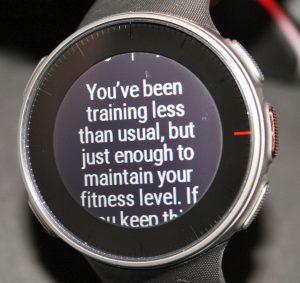
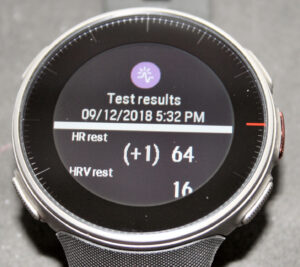





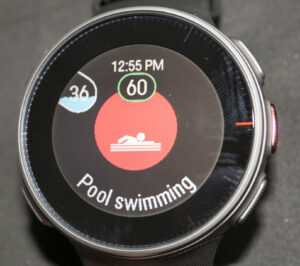


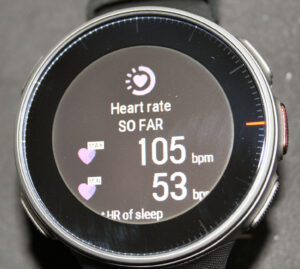








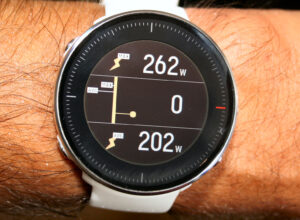


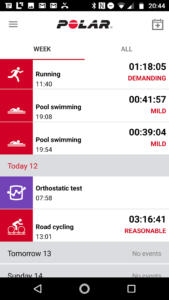
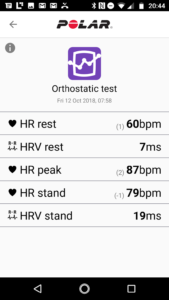


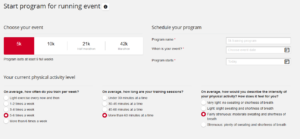
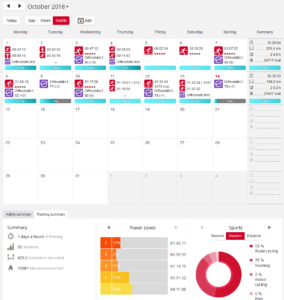

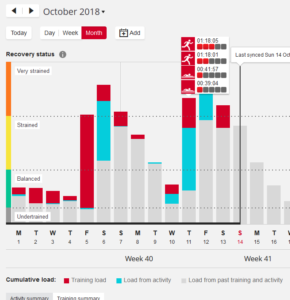



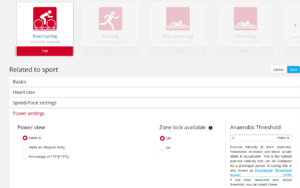
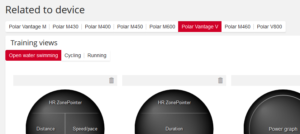

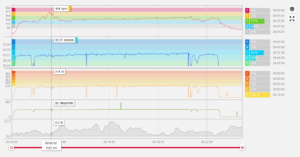

















Tolerance 40? ? hmmm, either you didn’t wear it for a long time, or something is wrong.
depends when the image was taken i guess
https://the5krunner.com/wp-content/uploads/2018/10/Capture-14.png
Did they ever update to include instant pace/distance from stryd? If not that’s a no go for most runners using that footpod.
I don’t understand this. The review says “By default, GNSS (GPS+GLONASS) is the source of pace and distance. An active and paired footpod makes no difference unless GPS is turned off in the sports profile.”
So to see an accurate pace from STRYD I need to turn GPS off? Or do I need to use a separate “data field”? Does this mean that GPS is completely off and I can’t even get GPS trace?
OK that’s changed and it was the case at launch. It’s not the case now.
I will change accordingly, thank you for raising this
Was there some sort of silent update to the Vantage M last week? I don’t feel qualified to comment on GPS accuracy as such, but I’m noticing live pace on the watch seems more like how I expect it to be for my effort just in the last week.
i’ve noticed some improvements on the V Titan.
I don’t think there will be any silent updates outside of firmware. could have been in the last firmware though. i think there may have been several ohr and gps improvements brought in that way.
Great review, thank You.
I have used a V800 for some years with great satisfaction. Mainly for the purpose of logging my training. Your review of the Vantage revealed features on the V800 that I did not know of ?.
Anyway, my V800 is damaged and I am offered a replacement at €250. The pricetag on a brand new Vantage M is € 215. Would You recommend a new V800 or the Vantage M? It is especially the GPS precision that I worry about. Also, how can I ensure that I get a “new” Vantage? ( As I understand Your review the first models are less precise…..)
hi
the v800 is one of the very best when it comes to gps. the M is better than the V but not better than the v800
there are subtle hardware differences from **ALL** manufacturers that are **continually** iterated and you nor I will likely never really know about any changes they introduce. i thought the v titan was different/better but now i’m not so sure and it’s probably jsut firmware improvements that all vantage devices have received. to answer your question in the ‘about’ sction there is a hardware number.
i think powermetercity sold out of vantage 2 weeks ago. so if they are now in stock i guess they’re new ones 😉 similarly in europe wiggle has a high turnover.
the only real ‘risk’ will be from vendors with low stock turnover and some from amazon that may turn out to be refurbs
Anyone else having confidence issues with the charging disk? My seems to have the magnetic sticking power of chalk. Had a few times of it not charging because the disk had come ‘unstuck’. Wondering if mine has broken.
could be broken…could be a call for support
with mine it can easily hold the vantage in the air fully by itself and the power of the magnet. obviously it only attaches in one exact position.
Ah yeah, bought it 2ND hand. Maybe influenced their selling. I see they are £10-20 on amazon. Might just grab a new one. Mine is Def not able to hold the watch in the air. Cheers for the reply.
Does the M allow for a 3s average power field?
no. not explicity
IIRC with bike power on the V800 you would choose to display the mooving average on FLOW but specify the duration on the V800. Vantage does not have that (yet)
running power: with STRYD you can make that setting on the pod (which is what I do to get a 3s power)
Thanks so much for the reply! Looking at getting my first gps watch and I understand they cater to running more than cycling, but I really hope they add this – pretty important for me on the bike.
vantage WILL be developed for some time.
ultimately a bike computer is the best for cycling…
I have a question. I really do like this watch. Polar flow is a far superior platform than connect IMO. My only issue with the watch is what appears to be a poor pace reading. It’s all over the place. I am in the market for a foot pod. With the inevitable winter on its way I’d like to try Zwift running. Enjoyed the cycling.
Question. Would a polar stryd foot pod help with pacing or would I be better wire a Stryd foot pod. Or neither? And advice would be great.
a footpod will improve things
i raced with a vantage titan yesterday. i used stryd
polar’s footpod should be fine
Talking about footpod. Since last week I use a vantage v next to my Suunto. Did two runs with an Adidas micoach footpod, total time of the runs with the vantage is much shorter (1 – 2 mins, on 5 – 12 km) compared to the SSU. Another run without footpod gives equal time on both watches. When zooming into the route in Runalyze I see many short track interruptions remarked with “Pause of 0:01”. Anyone else who did a comparison with two watches and a footpod? Wonder whether it is the footpod or a bug of the watch.
that does not sound right
switch the pods round on the watches and see if the problem reoccurs on the suunto
Update: Used the Adidas Speed Cell witrh the other watch and a Stryd with the Vantage. Worked well, both watches reported same running time. Just looking forward to the next update, instant pace in tree covered areas with a foot pod (even Stryd!) is a laugh.
Hi
Is it me or am I the only one having issues with my Vantage V not wanting to calculate my Running index????
It’s frustating. I think its needs overall allot of Firmware opdates. I like Polar but lately I’m getting disapoint by Polar.
mine definitely produced something last week
It has been a little bit since the watch has come out, since your review, and hopefully you still use the watch (it seems like you do). In your opinion, is this still “the watch to get”? i currently own a Sunnto 9 Baro (been a Sunnto user for years, Ambit 3, and Spartan), and its paired with a Stryd footpod, and when outside all is great, but once on the treadmill, its the worst experience ever, so I think its time to move (plus, the Suunto software leaves something to be desired). I thought about a FR945, but don’t need the music, and people really seem to like the Polar Software.. With winter coming, I will rely on the treadmill quite a bit, and I need something that works. Once I get frustrated, the experience is horrible and just makes me not want to run.
i’d recommend the 935 over the 945 for a ‘functional’ watch right now. i sold mine and replaced with a 945 and regret it a bit…although it will turn out fine next year once i have swapped it for one where the buttons work (mine have got stiff)
i do like the Vantage. i’m using the titan and sometiems the M. I’m not sure it ever was THE ‘watch to get’. i think a lot of people weren’t happy with it. however as a purists sports watch its pretty cool with the usual caveats for any sports watch that the ohr doens’t always work and the gps isn’t great #sigh. with FLOW and with the firmware that’s coming soon it’s going to be sweeter than a sweet thing. but not perfect.
not sure i answered your question despite waffling for a while
Sorry, when I said, “the watch to get”, I didn’t mean that for the masses, but I thought I read in the review that for 2019, it was the watch you were going to go use most of the time. I scanned the article but couldn’t find it easily… Looking at the market these days, Polar has a long way to come to be the product to get in any category..
My plan is to use it to help qualify for Boston, so accuracy, especially on a Treadmill is important. While the software is great, I don’t know how much I would technically need it, other than looking through it as I am long time Training Peaks and WKO3, then 4 and now 5 user. I have been a cycling coach for about 15 years, and for most of that Garmin was what you put on the bike, but now that I am running, there are so many options between Suunto, Garmin, Polar and now Coros, its not that cut and dry unless you can try one of them out..
It seems like every brand has that watch that ticks off 8 out of 10 boxes, but none of them get all 10, for me..
Hi Guys.
Can’t decide between Vantage M currently at ca. 200 EUR vs forerunner 245 at ca. 270 EUR – not sure if it makes sense to spend more on the garmin. Main purpose for me is to have some daily activity/sleep tracking, running, cycling and potentially indoor swimming. Also the running coach functionality with some training plans would be interesting. I am an amateur, want to use this to motivate myself more towards sports/fitness. I like the fact that on Garmin you can play around with watch faces – but it seems to be more of a gimmick rather than a life-changing functionality. What would be your thought on this? Thanks in advance!
Ive come to the polar from a FR235. The watch faces are a gimmick. Dont buy the watch on that feature. I really like my Polar. Feels like a quality watch and looks good for all dress codes. The FR is quite sporty looking. I hope the new firmware update for polar improoves aomethings but it’s as good as the Garmin. Polar flow is far better IMO than connect. I have the vantage V not an M to bear in mind.
+1 to what Rich said.
Thanks Guys! I just ordered the Vantage M 🙂
Anyone using screen protector on Vantage V? Any recommendation? A link perhaps? There are so many different items on ebay and amazon and it is hard to choose a quality one. Should I buy a plain one or tempered glass?
I know there is gorilla glass protection on Vantage V but I would still like to apply addition protector as I am working in harsh condition environment.
The million dollar question, when push comes to shove, would you go for the Polar Vantage V over a Garmin FR945 for both triathlon training and racing, when taking an overview of both the watch and the platforms used for each watch?
I’m interested in the Vantage V from a triathlon standpoint, especially with the additional features on the V.
I’m not bothered by having music on the watch or the ability to pay with it as the FR945 can do, but the number of features the FR945 has is staggering, but as you have pointed out in previous posts, how many of those do you actually use or need as an athlete? And when cycling, I use my bike computer anyhow, so the watch is just along for the ride (although the garmin tri sync is cool). Is the FR945 really worth the extra money compared the with Vantage? I also find the Garmin connect website a tad cumbersome; I’m currently a Movescount fan with my Suubto.
I know this question must be a tad old now, but after all the firmware updates with the vantage, it now seems a contender to replace my ambit2s.
yes it’s a million dollar question and obvisouly i’m now about to equivocate!!
-I used the M for some races this year. it worked.
-You rightly ask for a recommendation to cover “training and racing”. I pretty much know the metrics and things that I need and want to see for those. so FOR ME I can get them from Polar for sure…obviously Garmin too.
-Polar FLOW is a better platform than garmin or suunto. as you know MOVESCOUNT’s days are numbered. but you can equally use ELEVATE/stravistix NOW with your ambit 2 and see if you like it. then you can eliminate PLATFORM as one of the criteria
-most of my interest in metrics has moved on from HR in years gone by to POWER these days. though I prefer to use HR to quantify LOAD based metrics and decisions (buy 2x PMs ie STRYD + single-sided stages 105)
-935 is cool
-is the 945 worth the extra to ME…probably not. but i do use the NFC and music so i guess that’s worth something.
If I didn’t do this the5krunner.com thing, then I don’t think i would have bought a 945 to go with my wahoo. so that perhaps answers your question a bit. The REAL me DOES like gadgets but not quite as much as the5krunner does.
“-I used the M for some races this year. it worked.” – what is your go to watch, or does it depend on reviews?
“-935 is cool” – would you say it would be better to compare the Vatange with the 935?
While the Vatange can measure running power, so you prefer to pair it with stryd as the pod is more reliable?
-ELEVATE/stravistix – thanks for the tip! And thanks for all the reviews and replying to comments to your review!
I wanted to buy Garmin Forerunner 245 Music but I found it Polar Vantage V for the same price(280€ new).
Is it a better choice for running than Garmin F 245 ?
they are both good.
it depends onthe features that are importnat to you
both have LOTS of features.
clearly music is only on one of them….
Thx
5k:
I’ve read and reread your review several times. I currently have use the AW3 and Stryd. It’s a great combination and works almost flawlessly.
The only reason I’m considering another watch is due to the AW3’s battery life. I’ve recently started to run more Ultra trails. Twice I have the AW3 die on the trail. I realize it’s not designed for this activity, but it’s what I currently own.
I’ve never owned a true running watch. I’ve narrowed my choices down to the Vantage V and the Garmin 945. The V checks all the boxes, as does the 945. I just don’t understand the following using Stryd:
1. If using the Stryd on the V, will I get all the other features the watch offers? For example, pacing, GPS, routing, etc…?
2. If using the Stryd on the 945, I have to use the Stryd App. Does that negate other features on the 945, like ClimbPro?
I hope you understand the question. I’m looking for the watch that best integrates with Stryd and allows me to use the watch’s capabilities. Am I asking too much of either watch?
it must be enthralling reading. maybe i should be clearer so you only have to read it once 😉
1. yes
2. no/yes. you dont have the use the stryd app but rather a data field (as a minimum). a datafield fits in to what you are doing, an app takes over everything (broadly)
Thank you. That helps tremendously.
First, thank you so much for all the time, testing, and research you have put into your (extremely) well articulated reviews!
I am a Mixed Martial Artist currently using a Garmin Forerunner 245 to track the progress of, and improve upon, my cardiovascular conditioning. I have found the Firstbeat apps both helpful and interesting, but am looking at the Vantage V for the apparent increase in functionality and metrics it provides (I have no need for smartwatch features).
The questions I have been unable to answer:
1) Polar Flow appears to be more comprehensive than Garmin connect, but you seem to prefer using a thrid party interface for metric tracking (i.e. Sports Tracks). Do you still feel the Vantage is more metric rich compared to the Garmin offerings, when you take their native interface (Connect/Flow) out of the equation?
2) My Strength & Conditioning coach and I will be in different countries for the next couple years. Which platform (Garmin/Polar), in your opinion, is going to give him the most useful training metrics/allow him to build training plans for me to follow? (I understand this might be somewhat outside of your purview, but from what I have been able to gather, Garmin does not have an option to build custom training programs… not sure if there is a workaround for this).
Once again,
Thanks for all your help!
-Sterling
hey there, thank you for the question.
1. no, when compared to top-end Garmins
2. he should have an opinion on that as he will be defining what you need to do and especially because you are presumably paying him. I don’t really have an opinion on what is best for defining and monitoring an S&C plan…spreadsheet? you CAN build complex structured workouts in Garmin connect
Thanks so much for the quick reply! Looks like I have a bit more reading to do.
Hi, Vantage M+V has a “livetrack” mode? Can’t find any info on that, and it seems Garmin only offer this kind of feature…
breadcrumb route?
No, livetrack mode, this the name used by Garmin, when your family can follow you on live. You have to bring your cellphone with you.
that’s a garmin feature
a similar thing exists on other platforms like Strava (Beacon), not Polar AFAIK
you would need cellular access in any case…just use an app on your phone!! eg there are native abilities in iOS
Ok, thanks!